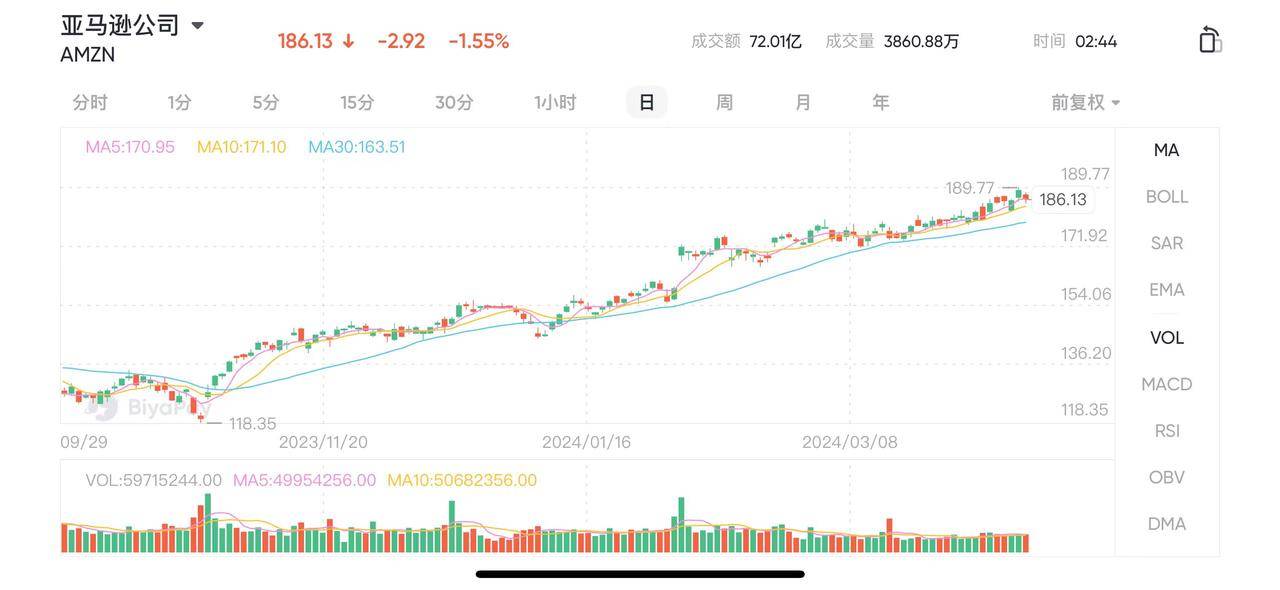- Remittance
- Exchange Rate
- Stock
- Events
- EasyCard
- More
- Download
New AI Powerhouse Amazon Quietly Makes Moves, Stock Price Rise Surpasses Microsoft and Google, Marke
It’s just over three months into the year, and the market value rankings of U.S. tech giants have already changed, with the AI wave tumultuously reshaping market valuations. Microsoft, leveraging its investment in OpenAI and its own deep cultivation in the AI field, has surpassed Apple, firmly sitting at the top in market value. Nvidia, capitalizing on its dominant position in the AI chip sector, has outpaced Google, claiming the crown as the third-largest tech stock by market value. This dramatic shift is a vivid illustration of the global AI frenzy driving a continuous surge in the U.S. stocks.
However, the focal point of widespread attention isn’t limited to this. Amazon, quietly gathering strength in the AI race, has seen its stock price increase silently surpassing the duo of Microsoft and Google. Last year, Amazon’s stock soared by 80.88%, far exceeding Microsoft and Google’s 58%; entering the new year, its increase remains high at 24.42%, overshadowing Microsoft and Google’s 14%. Now, Amazon’s stock price continues to soar, setting new records, with its market value breaking through the $1.96 trillion mark.
Amazon’s stock price has continued to climb recently, now reaching a record high, with a closing price of $186.13 on April 13, 2024, as displayed by the multi-asset trading wallet BiyaPay, with a market value of $1.96 trillion.

So, why has Amazon’s stock price been continuously rising?
According to analysts from BiyaPay, three key factors are behind Amazon’s triumphant stock price performance: first, its excellent performance in revenue and profit, both turning positive, achieving a splendid turnaround; second, its successful inclusion in the Dow Jones Industrial Average, joining the ranks of Apple and Microsoft in the blue-chip arena; third, its precise AI strategic layout, driving business development through innovation, unleashing massive growth potential.
E-commerce Business: Breaking Through Adversity, Significantly Enhanced Profitability
In 2023, Amazon’s total revenue surged by 11.83% to $574.785 billion, achieving a turnaround from loss to profit, with net income jumping to $30.425 billion, an astonishing reversal from the previous year’s loss of $2.722 billion. Both operating cash flow and free cash flow also showed strong vitality, soaring to $84.946 billion and $36.813 billion, respectively.
The North American business segment strongly recovered, with revenue growth of 11.70% reaching $352.828 billion, and operating profit turning from a loss of $2.847 billion last year to a profit of $14.877 billion. The fourth quarter even saw a surge, with revenue growth accelerating to 13.01% and operating profit breaking through to $6.461 billion, a stark contrast to the performance in the first three quarters.
The international business also showed signs of dawn, with revenue increasing by 11.18% to $131.2 billion, and operating losses significantly narrowing to $2.656 billion, half of the previous year’s $7.746 billion, showing a clear improvement.
AWS Cloud Business: Resilience and Transformation Amid Scale Expansion and Profit Margin Fluctuations
As a global leader in cloud computing, AWS saw a 13.31% increase in annual revenue in 2023, reaching $90.757 billion. Although the growth rate of divisional operating profit slowed to 7.84%, recording $24.631 billion, there was a 1.38 percentage point slide in operating profit margin to 27.14%. Notably, in the second half of the year, AWS’s operating profit margin rebounded, increasing by 3.95 and 5.26 percentage points in consecutive quarters, showing a robust recovery.
Amazon’s first-quarter performance guidance is promising, with an expected net sales range of $138 billion to $143.5 billion, a year-over-year increase of 8% to 13%, stronger than the same period last year, considering an approximate 40 basis point impact from exchange rates. The operating profit guidance is between $8 billion and $12 billion, compared to $4.8 billion in Q1 2023, indicating a significant improvement in profits.
AI Strategy: Deep Layout, Comprehensive Approach
Amazon’s competitive logic in the AI field is unique. Facing the formidable status of OpenAI, Amazon decisively invested $1.25 billion in its competitor Anthropic in September 2023. Although this amount is less than Microsoft’s massive $10 billion investment in OpenAI, in the context of venture capital contraction, this move clearly shows its ambitious determination in the AI race.

Subsequently, Amazon increased its investment to $4 billion, establishing deep cooperation with Anthropic:
Chip Cooperation and Technology Sharing:
Anthropic will use AWS’s Trainium (training) and Inferentia (inference) chips to jointly develop the next generation of large models. AWS will become the core cloud service for Anthropic’s critical missions, including security research and future model development. Anthropic promises that its latest large models will be accessible to global AWS customers through Amazon’s Bedrock platform.
Model Customization and Service Integration:
Anthropic will provide AWS customers with early model customization and fine-tuning privileges, enabling Amazon developers and engineers to upgrade applications using Anthropic models, seamlessly integrating generative AI features.
Building AIGC Investment Matrix:
Amazon CEO Andy Jassy reveals that the company views generative AI as a three-layer technology stack, with each layer receiving substantial investment. The bottom layer focuses on computing and customized chips, with AWS already launching the second generation of Trainium and Inferentia products, offering a cost-performance ratio that surpasses competitors, winning the favor of customers such as Anthropic, Airbnb, Hugging Face, and many others. The middle layer provides a one-stop hosted service through Amazon SageMaker and Amazon Bedrock, helping customers quickly build and expand generative AI applications, attracting tens of thousands of users, including well-known companies such as ADP, Delta Air Lines, Pfizer. The top layer creates a rich AI application scenario, such as shopping assistant Rufus, smart speaker Alexa, advertising tools, customer service solutions, etc., and launches Amazon Q, achieving functions such as code writing, debugging, testing, migration, and data querying, empowering digital transformation across industries.
Amazon Investment Method Sharing
It is because of the above reasons that Amazon’s stock price has been on the rise. So, how should investors invest in Amazon stocks?
As we know, investing in U.S. stocks requires using dollars, but many brokers cannot directly deposit local currency. Therefore, I suggest that investors, according to their investment strategy, use the BiyaPay App multi-asset trading platform to invest. No overseas bank account is needed; simply deposit digital currency and convert it to dollars to invest in Amazon on the platform, with real-time deposits and withdrawals; additionally, the platform also supports digital currency exchanges for USD/HKD, allowing withdrawals to Charles Schwab or other securities for investment trading, achieving fast and unlimited transactions, truly convenient. Investors can carry out investment transactions according to their needs.

Conclusion
Amazon’s e-commerce, advertising, and content businesses continue to maintain robust growth space driven by market penetration. On the foundation of AWS, a cornerstone of profits, Amazon, by deeply laying out the AI three-layer tech stack and building a comprehensive service ecosystem, strengthens the synergistic effects with AWS services, aiming to consolidate its leading position and enhance revenue and profit levels. This highly attractive strategic narrative is the deep logic behind Amazon’s recent stock price surge, indicating its strong competitive strength and broad prospects in the tech giants’ battle.

























